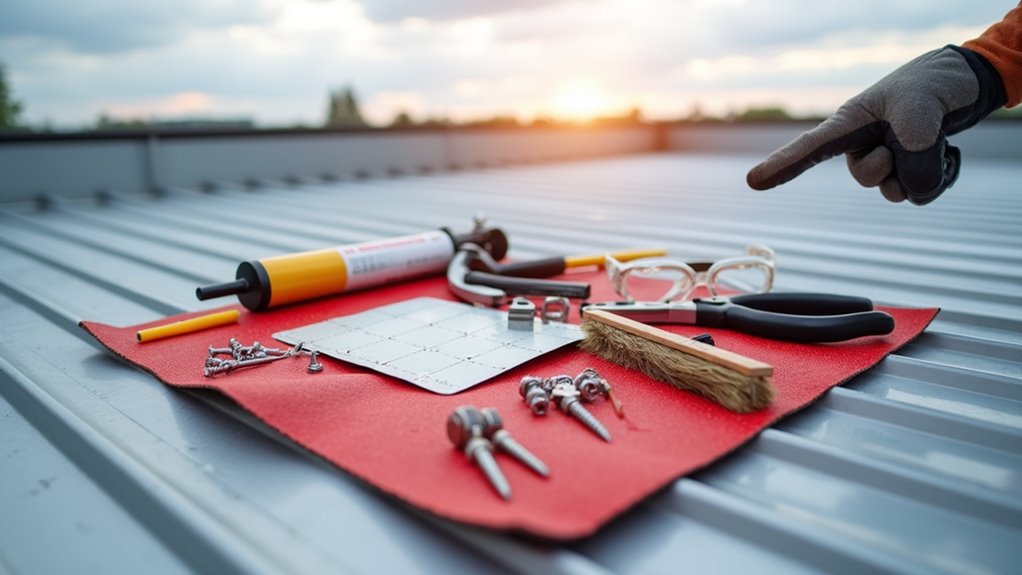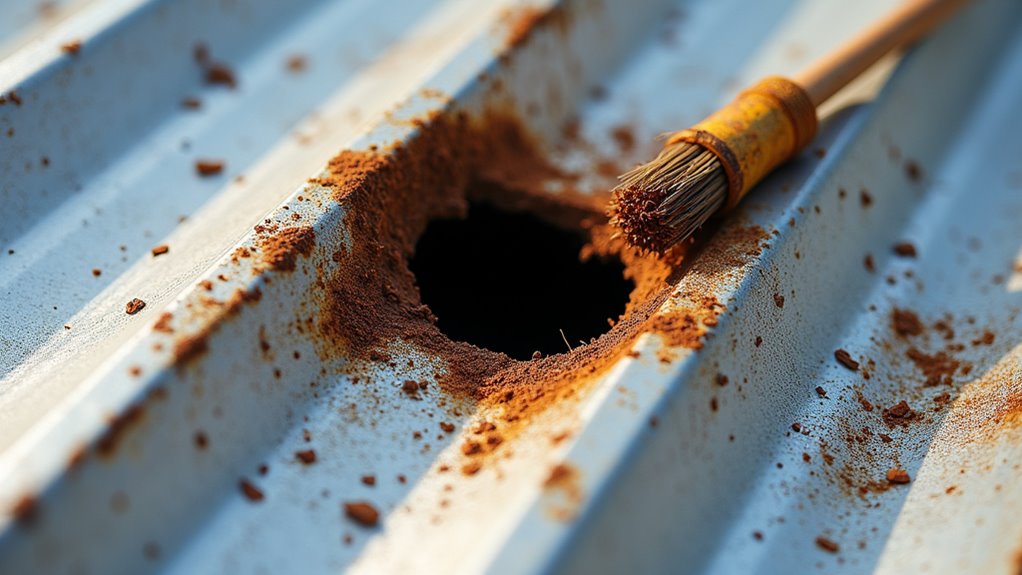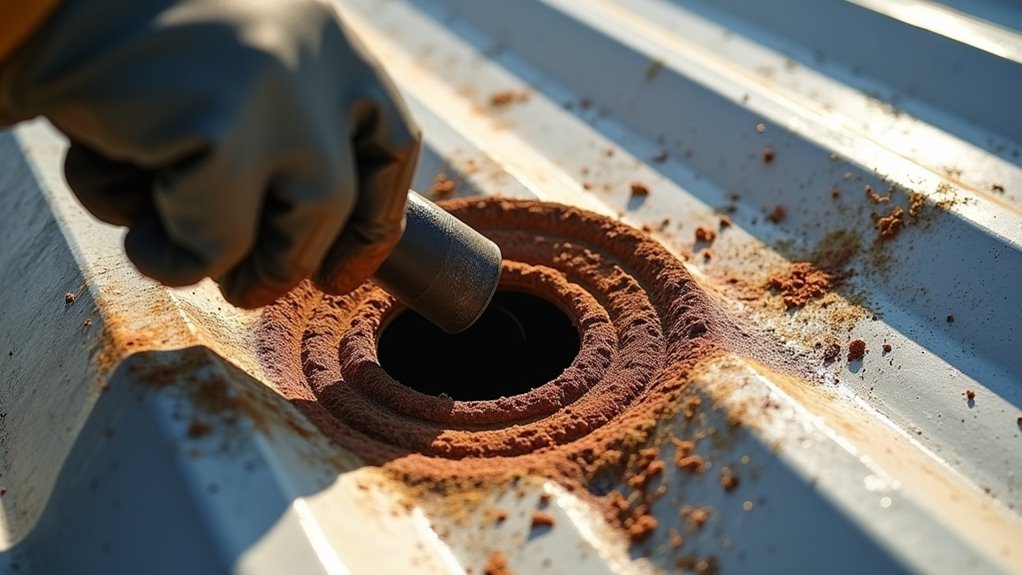To repair metal roof holes, you’ll need safety gear, metal shears, roofing sealant, and a metal patch. Initially, guarantee stable ladder placement and check weather conditions. Clean the damaged area thoroughly with a wire brush and mineral spirits. Cut your patch 2 inches larger than the hole, apply sealant around the perimeter, and secure with sheet metal screws every 2 inches. Test with water and maintain regular inspections. The following detailed steps will guarantee a professional-quality repair.
Safety Preparations and Required Tools

Three essential safety measures must be taken before attempting any metal roof repairs: checking weather conditions, ensuring stable ladder placement, and wearing appropriate protective gear. Don’t proceed if there’s rain, strong winds, or extreme temperatures forecast. Your safety gear should include non-slip boots, heavy-duty gloves, safety goggles, and a secured safety harness.
For the repair itself, you’ll need these essential tools: metal shears, a wire brush, roofing sealant, a putty knife, a measuring tape, and appropriate metal patches that match your roof material. Keep a caulking gun, screwdriver, and drill with metal bits readily available. Furthermore, gather cleaning supplies such as acetone or mineral spirits to prepare the repair area properly. Store all tools in a secure tool belt to maintain stability while working at height.
Assessing the Damage and Cleaning the Area

Before initiating any repairs, conduct a thorough inspection of the damaged area to determine the hole’s size, shape, and surrounding metal condition. Your damage evaluation should identify any rust, corrosion, or structural weakness that might affect the repair’s durability.
| Assessment Step | What to Check | Action Required |
|---|---|---|
| Visual Inspection | Hole dimensions | Measure precisely |
| Surface Analysis | Rust presence | Mark affected zones |
| Structural Check | Metal integrity | Note weak spots |
| Area Preparation | Debris presence | Clean thoroughly |
Start area cleaning by removing all dirt, debris, and loose material from a 6-inch radius around the hole. Use a wire brush to scrub away rust and loose paint, then wipe the surface with mineral spirits. You’ll need the area completely clean and dry before applying any repair materials to guarantee proper adhesion.
Preparing the Surface for Repair

Proper surface preparation directly impacts the longevity and effectiveness of your metal roof repair. After evaluating the damage, you’ll need to guarantee ideal surface cleaning by removing any remaining rust, debris, or loose material around the hole using a wire brush or sandpaper. Work in a circular motion until you achieve a smooth, clean surface that’s free from contaminants.
To achieve repair readiness, wipe the area with mineral spirits or acetone to remove oils and residue. Let the surface dry completely before proceeding. If you’re working with galvanized metal, lightly scuff the surrounding area to create better adhesion for the repair materials. You’ll know the surface is properly prepared when it’s clean, dry, and slightly textured. Don’t skip these vital steps, as they’ll determine how well your repair bonds to the existing roof.
Applying the Patch and Sealant
Once you’ve properly prepared the surface, begin by cutting a metal patch that extends at least 2 inches beyond all edges of the hole. Confirm your patch materials match the existing roof’s metal type and gauge to prevent galvanic corrosion.
Apply a thick bead of roofing sealant around the hole’s perimeter, then press the patch firmly into place. Secure the patch using sheet metal screws every 2 inches along its edges. Don’t overtighten the screws, as this can dimple the metal and create water collection points.
Complete the repair by applying sealant application around the entire patch perimeter and over all screw heads. Use a putty knife to smooth the sealant, confirming complete coverage and proper adhesion. Allow the sealant to cure according to the manufacturer’s specifications before exposing it to moisture.
Testing and Maintenance Tips
After the sealant has fully cured, you’ll need to verify the effectiveness of your repair through a thorough water test. Spray the repaired area with a garden hose, directing water from multiple angles to guarantee complete coverage. Monitor the underside of the roof for any signs of leakage.
To maintain your metal roof’s integrity and prevent future holes, implement these preventive maintenance steps:
- Schedule bi-annual inspection routines to check for loose fasteners, rust spots, and deteriorating sealants
- Clear debris from valleys and gutters every three months to prevent water pooling and corrosion
- Trim overhanging branches that could damage the roof during storms
If you notice any issues during your maintenance checks, address them immediately to prevent minor problems from becoming major repairs. Document your inspection findings for future reference.
Frequently Asked Questions
How Long Will a Metal Roof Patch Typically Last?
A properly installed metal roof patch can last 10-15 years if you maintain it well. The patch longevity depends heavily on your initial preparation and application technique. You’ll get the best results when you regularly inspect the patch, keep it clean, and reapply sealant as needed. For maximum durability, it’s essential that you’ve used compatible materials and followed proper maintenance tips, including addressing any rust formation promptly.
Can I Repair Metal Roof Holes During Winter or Rainy Conditions?
You shouldn’t attempt metal roof repairs during winter or rainy conditions. Moisture can prevent proper adhesion of sealants and patches, while cold temperatures below 50°F make many roofing materials less effective. If you must address an urgent leak, you’ll need to thoroughly dry the area and use a temporary emergency patch. For lasting results, wait for dry weather and temperatures above 50°F before performing permanent repairs.
Will Patching Affect My Roof Warranty?
Patching your metal roof can indeed affect your warranty coverage, so you’ll need to check your specific warranty terms before proceeding. Many manufacturers void warranties if unauthorized repairs are made. If you’re still under warranty, it’s best to contact your roofing manufacturer or authorized contractor initially. Even approved patching techniques might need to be documented and performed by certified professionals to maintain your coverage. Don’t risk invalidating your warranty with DIY repairs.
What Causes Metal Roof Holes Besides Obvious Physical Damage?
Besides physical impacts, you’ll find that metal roof holes often develop from several environmental factors. Corrosion causes significant damage when metal panels are exposed to chemical pollutants or incompatible metals that trigger galvanic reactions. Weather impacts like prolonged moisture exposure, freeze-thaw cycles, and acid rain can accelerate deterioration. You’ll also notice holes forming where fasteners have worked loose, allowing moisture to penetrate and compromise the metal’s integrity.
Should I Replace the Entire Metal Roof if There Are Multiple Holes?
You don’t necessarily need a complete roof replacement if you have multiple holes. Consider these factors: if the holes affect less than 30% of your roof’s surface, repairs are typically more cost-effective. However, if your metal roof is over 20 years in service or shows widespread deterioration, replacement might be your best option. Compare repair costs against full replacement expenses, factoring in the roof’s lifespan, general condition, and extent of damage.

